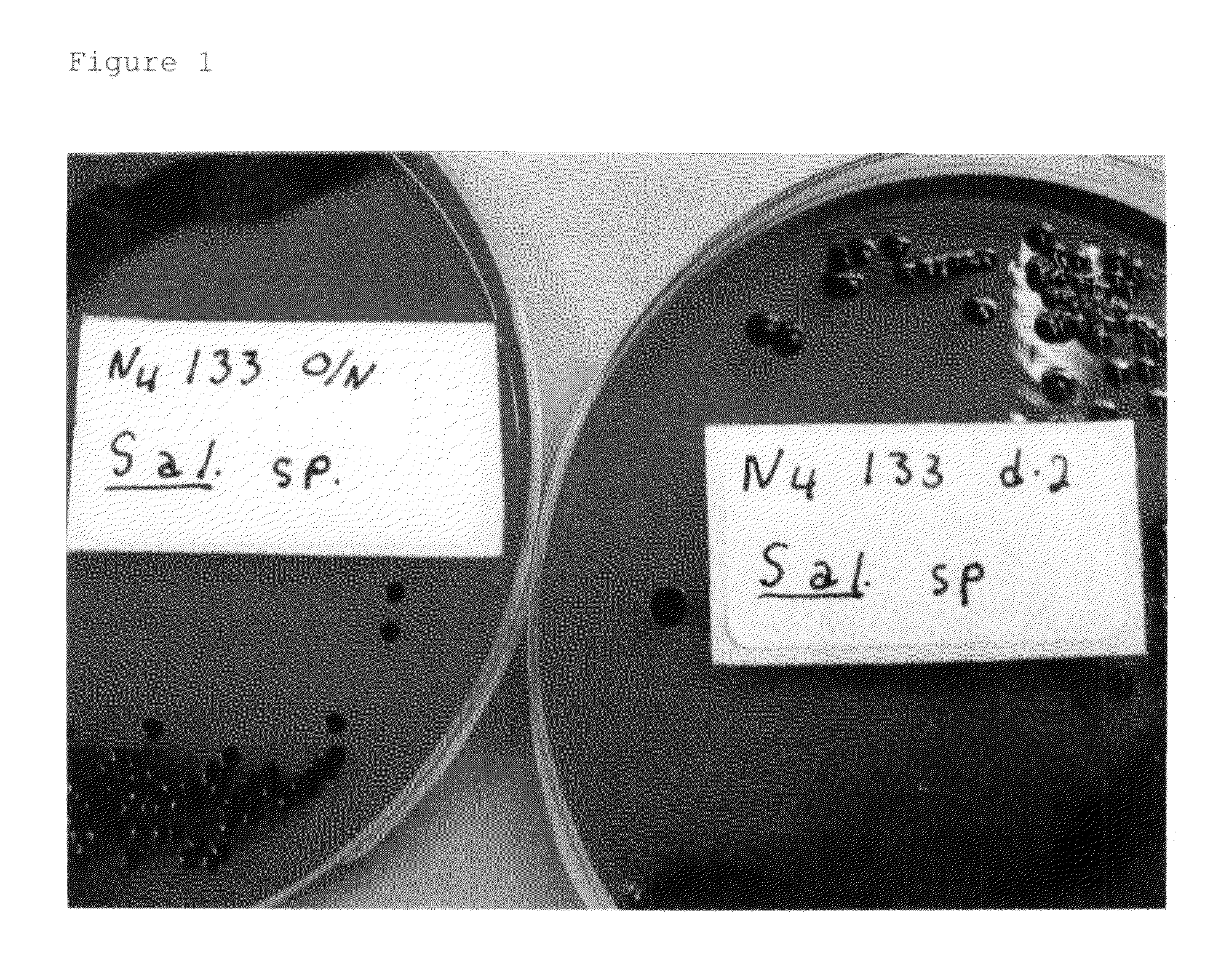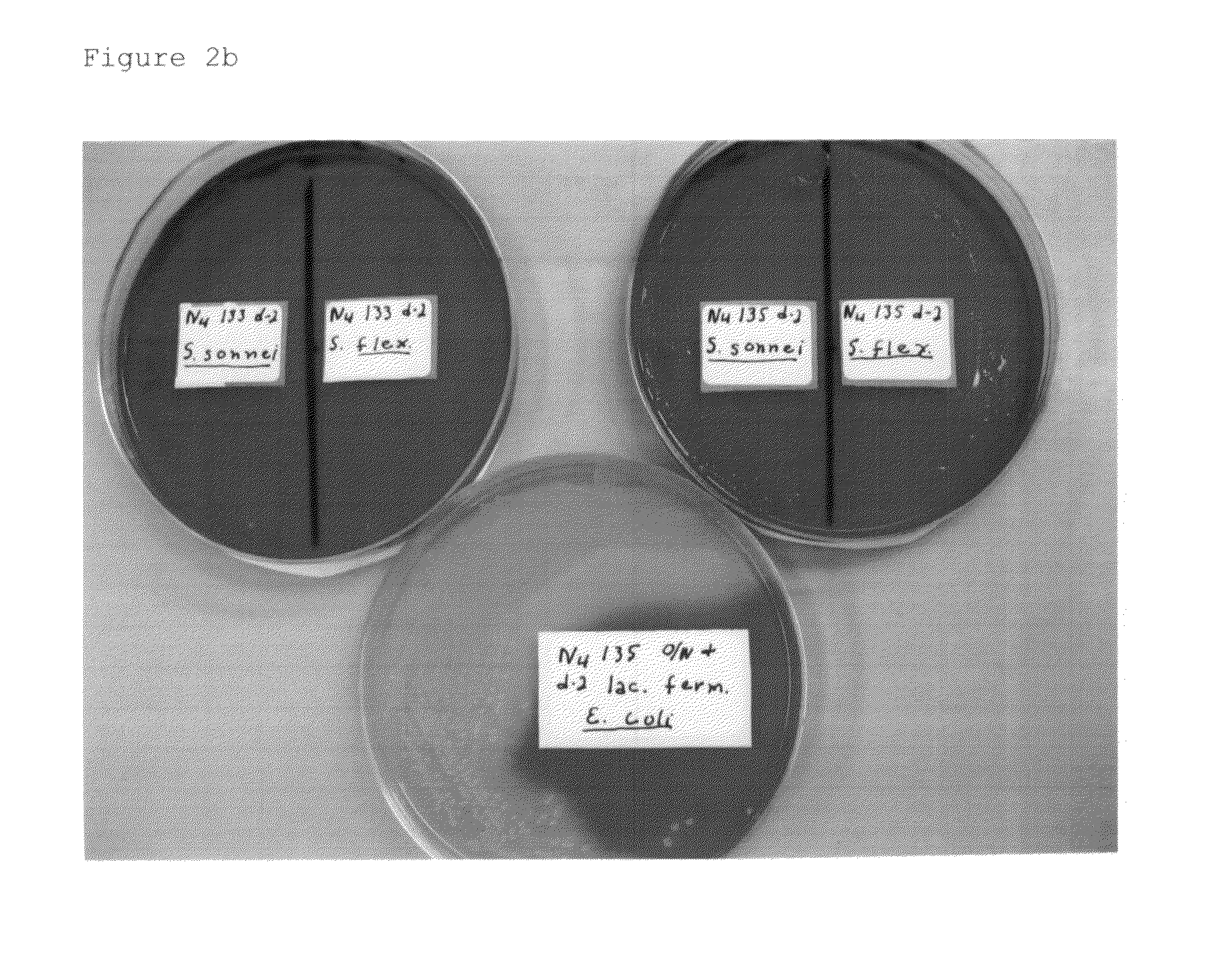Advanced selective plating media
a technology of selective plating and media, applied in the field of selective plating media, can solve the problems of not being able to detect i>salmonella /i>spp. and i>shigella /i>spp. in human diagnostic applications, not being able to achieve the full detection of i>salmonella /i>spp. and i>shigella /i>spp., and achieve greater
- Summary
- Abstract
- Description
- Claims
- Application Information
AI Technical Summary
Benefits of technology
Problems solved by technology
Method used
Image
Examples
example 1
General Media N4 Agar
[0045]In a first embodiment of the selective plating media of the present invention, a general selective N4 agar can be made by mixing with one liter of water with the following ingredients:[0046]a) between about 3.0 to about 30.0 g yeast extract;[0047]b) between about 0.0 to 10.0 g proteose peptone No. 3;[0048]c) between about 0.0 to 15.0 g proteose peptone;[0049]d) between about 0.0 to 10 g L-lysine;[0050]e) between about 0.0 to about 8.0 g xylose;[0051]f) between about 0.0 to about 15.0 g alpha lactose;[0052]g) between about 0.0 to about 15.0 g sucrose;[0053]h) between about 0.0 to about 15.0 g (D+)-cellobiose;[0054]i) between about 0.0 to about 15.0 g salicin;[0055]j) between about 0.0 to about 8.0 g dulcitol;[0056]k) between about 0.0 to 5.0 g sodium chloride;[0057]l) between about 5.0 to 8.0 g sodium thiosulfate;[0058]m) between about 0.6 to 1.0 g ferric ammonium citrate;[0059]n) between about 0.05 to 0.2 g phenol red; and[0060]o) between about 10.0 to 20....
example 2
N4 Formula 273
[0063]In another preferred embodiment of the selective plating media of the present invention, a selective N4 agar is made by mixing with one liter of water with the following ingredients:[0064]a) between about 7.5 to about 15.0 g yeast extract;[0065]b) between about 3.0 to 6.0 g proteose peptone No. 3;[0066]c) between about 3.0 to 6.0 g proteose peptone;[0067]d) between about 4.0 to 6.0 g L-lysine;[0068]e) between about 2.0 to 4.0 g xylose;[0069]f) between about 10.0 to 15.0 g alpha lactose;[0070]g) between about 10.0 to 15.0 g sucrose;[0071]h) between about 10.0 to 15.0 g (D+)-cellobiose;[0072]i) between about 4.0 to 8.0 g salicin[0073]j) between about 2.0 to about 4.0 g dulcitol;[0074]k) between about 0.7 to 0.9 g ferric ammonium citrate;[0075]l) between about 6.0 to 7.0 g sodium thiosulfate[0076]m) between about 0.08 to 0.10 g phenol red;[0077]n) between about 12.0 to 14.0 g agar; and[0078]o) between about 4.0 to 8.0 ml 7-ethyl-2-methyl-4-undecanol hydrogen sulfate...
PUM
| Property | Measurement | Unit |
|---|---|---|
| temperature | aaaaa | aaaaa |
| thick | aaaaa | aaaaa |
| temperature | aaaaa | aaaaa |
Abstract
Description
Claims
Application Information
 Login to View More
Login to View More - R&D
- Intellectual Property
- Life Sciences
- Materials
- Tech Scout
- Unparalleled Data Quality
- Higher Quality Content
- 60% Fewer Hallucinations
Browse by: Latest US Patents, China's latest patents, Technical Efficacy Thesaurus, Application Domain, Technology Topic, Popular Technical Reports.
© 2025 PatSnap. All rights reserved.Legal|Privacy policy|Modern Slavery Act Transparency Statement|Sitemap|About US| Contact US: help@patsnap.com



